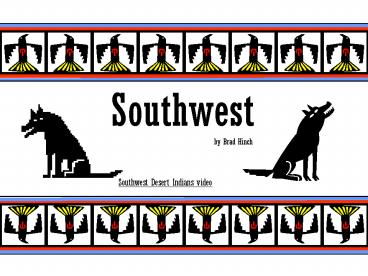Southwest - PowerPoint PPT Presentation
1 / 15
Title:
Southwest
Description:
Southwest – PowerPoint PPT presentation
Number of Views:65
Avg rating:3.0/5.0
Title: Southwest
1
Southwest
by Brad Hinch
Southwest Desert Indians video
2
Objective Students will become knowledgeable
about the daily life, traditions and locations of
the Southwest Indians of North America.
Gasconade County R-2 Schools
3
The Hogan
The Navajo lived in homes called hogans. Hogans
were round houses built with forked sticks. The
sticks were covered with brush, packed earth,
hides, and whatever was available. The front door
of the hogan always faced east to catch the first
light of the morning sun. Later the Navajo built
a six-sided hogan of logs and mud. The hogan
always had only one room. Some had tables,
chairs, beds, and wood-burning stoves. Outside
the home a loom for weaving was set up. It was
brought indoors only in the winter. A corral for
the herd of sheep was close by the hogan. Homes
were far apart from each other. The Navajo
blessed their homes in a special ceremony to
bring it good luck and happiness
4
The Indians of the Southwest Culture lived in
apartment-style buildings. These buildings were
made of adobe, clay and vegetables dried in the
sun. This type of home was especially good for
areas that had very little rainfall and a hot
desert climate. Many families lived in each
apartment. As families grew, rooms were added on
top of the rooms that were already there.
5
Built of masonry -- squared rocks on rocky mesas
and mountains -- or of adobe, a clay mixture, on
desert flats where there is little rock, these
flat-topped buildings of many rooms, often
stacked, are an ancient form of Native housing,
in the southwest. Mesa Verde, built by the
ancient Anasazi, was abandoned during a long
drought in the 13th century, stands in ruins in a
mesa cliff cave. It inspired Hopi potter-engineer
Al Qoyawayma to make this wonderful pot depicting
it. The Anasazi from here (and the large
settlements in Chaco Canyon) resettled among the
many pueblos along the Rio Grande river. Ancient
Anasazi probably are among Qoyawayma's ancestors,
some who ultimately settled on the 3 Hopi mesas
in Arizona.
6
(No Transcript)
7
Chief Pattern Blanket, Third Phase 1880-1885,
Berlant Collectionderive from the Pueblo cloud
and rain design that is very similar. Even
diamonds may owe something to Pueblo diamond
designs such as stylized bird motifs in which the
feathers are triangles and the overall shape
diamond or diamond twill, which is the dominant
Pueblo weave. Diamonds had also been used on
Navajo blankets.
8
Plain Stripe Blanket Worn by Ash-tish-kel,
Southwest Museum, L.A.
Classic Child's Blanket, c. 1870-5, Berlant
Collection, L.A.
9
Eye-Dazzlers not only used brilliant colors,
primarily from the warm range, but more dramatic
patterns (fig. 15 16). Serrated or sawtooth
diamonds and zigzag lines heighten optical
effects. There are afterimage or reversal
effects through color and pattern. More
significantly the direction
10
Two Grey Hills Rug, Museum of Northern Arizona
11
Yei Rug, Read Mullen Collection
Sand Painting of Father Sky Mother Earth
12
Koshare clowns try to climb a pole at one of Taos
pueblo's sacred dances, painted by famed Santa
Clara painter Pablita Velarde in 1947.
13
KACHINAS Kachina dolls were carved out wood by
the Zuni and Hopi tribes. They clothed them in
masks and costumes to look like the men who
dressed up as Kachina spirits. They were given to
children to teach them to identify the different
parts of Kachina dolls, and the parts they play
in tribal ceremonies. The Kachinas, or Gods,
were beings of a great might and a great power to
the Native Americans. They were known to come
down to earth and actually help the native
Americans tend their fields and give them wisdom
about agriculture, and law and government. They
physically interacted with the people themselves.
There have been drawings of these Kachinas on
cave walls. In many ways they correspond to the
kinds of drawings we see in the Nasdak Plains but
in much larger form.
14
FOOD The very first Southwest Native Americans
hunted mammoths until they became extinct. Then
people began to hunt buffalo, also known as
bison, as well as collect wild plants for food.
They also learned to grow maize, or corn, that
was their most common grain, which became
domesticated in Mexico. Corn is the central food
of daily life, and piki - paper thin bread made
from corn and ash--is the dominant food at
ceremonies. Corn relies on the farmer to survive,
and the Hopi relies on the corn - all life is
designed to be interrelated. The Hopi Indians
grew food similar to the Navajo Indians. They
raised corn or maize as the basic food. The Hopi
Indians based religious ceremonies on the corn
they grew.They grew 24 different kinds of corn,
but the blue and white was the most common.They
also grew beans, squash, melons, pumpkins, and
fruit.
15
References
Page 1 People of the Southwest Desert -Video
www. Unitedstreaming.com
Page 3, 4 Hogans//adobe http//www.mce.k12tn.n
et/indians/reports2/navajo.htmH
Page 4 - Pueblo picture http//www.nativeamerica
ns.com/Wigwams.htm
Page 5 - Mesa Verde picture and information,
Koshare clowns http//www.kstrom.net/isk/maps/h
ouses/pueblo.html
Pages 6 - Basket, jeewelry, and pottery
http//www.artsconnected.org/about/restrictions.h
tml
Pages 7 10 - Blankets -http//sorrel.humboldt.ed
u/rwj1/navb/nov15.html
Page 12, 13 - Kachinas - http//www.crystalinks.co
m/hopi1.html































